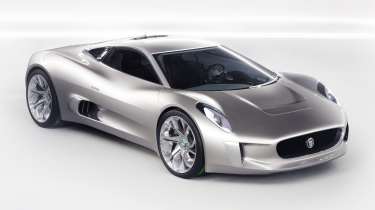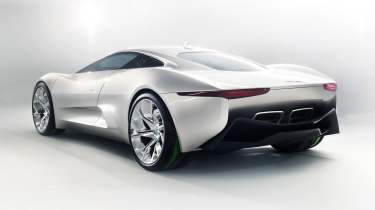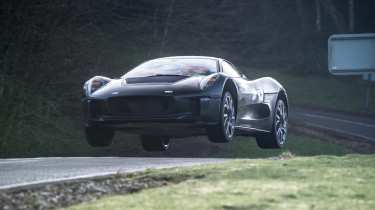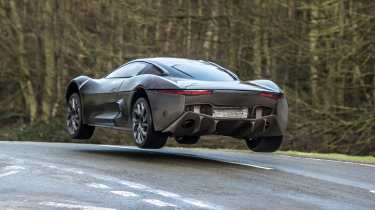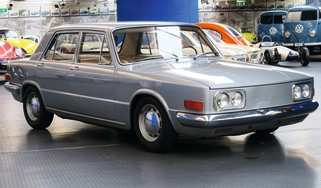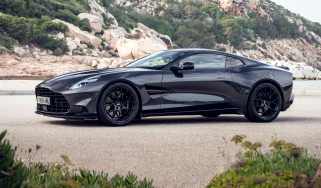Jaguar C-X75 – dead on arrival
It's unimaginable now but here was a Jaguar concept that absolutely everyone loved... and mourned when it didn't make production
The C‑X75 concept was revealed at the 2010 Paris motor show, ostensibly as a stunning, XJ13-inspired way to celebrate Jaguar’s 75th birthday. Behind the scenes, however, there was more to it than that.
The birthday story was neat, but the car was really conceived by the Jag design studio as a three-dimensional mission statement to remind navel-gazing management that Jaguars should be, above all, fast and beautiful. Its other job was to highlight Jag’s work in future propulsion tech and, since the company had already shown off a prototype XJ with a range-extender powertrain, it made sense for the C‑X75 to take this thinking one step further.
> 2013 Jaguar C-X75 prototype review
So the concept had four electric motors, one per wheel, and on-board electricity generation from two microturbines made by British company Bladon Jets. At least, in theory it did. In practice, the show car could be (gently) driven but powered by just one electric motor and no jets. Nonetheless, the whole thing seemed so fantastically exciting that it couldn’t remain just a one-off.
Sure enough, in May 2011 Jaguar announced that it was going to build the C‑X75 in a run of 250 cars costing ‘from £700,000’ and with first deliveries in 2013. To meet this tight timetable Williams Advanced Technology was brought in to get the car ready for the street and was given a set of challenging targets: the production car had to have the 0-100mph performance of a Veyron, the CO2 emissions of a Prius and the EV range of a Chevrolet Volt. Oh, and it had to look exactly like the original concept car.
To achieve these lofty goals the glorious skin couldn’t change, but everything under it had to. So where the concept was built around an aluminium understructure dressed in plastic, the production car would use an ultra-stiff carbonfibre hull covered in carbon panels.
> Road-going Jaguar C-X75 one-off realises the stillborn hypercar's potential
And while those tiny jets were a nice idea, they generated too much heat to be practical, so the powertrain was reinvented as a plug-in parallel hybrid using an electric motor per axle feeding from a 19kWh battery mounted behind the seats and just in front of an astonishing 1.6-litre four-cylinder engine derived from an ill-fated Cosworth F1 project. This would rev to 10,200rpm and, with help from a turbocharger and supercharger, deliver 502bhp.
Total system output was beyond 850bhp, giving a 0-62 time of under three seconds and a top speed of 220mph. True to the brief, pure EV range was around 40 miles and the official CO2 figure just 89g/km. Packaging all of this tech without ruining the concept car shape took some lateral thinking, which is why, for example, the fuel tank ended up under the centre console.
Keeping all the various powertrain elements at the right temperature was even more of a challenge and demanded a total of ten radiators, forcing Ian Callum and his design team to add some subtle new intakes and outlets to the show car’s shape.
With the engineering set and the style adapted to suit, five prototypes were made and for 18 months Jaguar and Williams engineers cracked on with development work until dark clouds gathered over the project. The global economy was not at its most healthy and plenty of people at Jaguar remembered the last time the company tried to sell a flagship supercar against a backdrop of financial uncertainty. Haunted by the memory of unsold XJ220s, in December 2012 Jaguar management cancelled the C‑X75. The prototype fleet continued testing for a while in the name of R&D, one of the cars was reduced to dust after an unfortunate thermal incident at the Gaydon test track, and then a sheet was quietly pulled over the whole project.
Except the C‑X75 was too pretty to disappear and rose again for the 2015 Bond film Spectre as the transport of Dave Bautista’s bad guy, Mr Hinx. To make this possible, Jaguar and Williams tidied up two of the engineering prototypes to be used for close-up hero shots and built a batch of five stunt cars with steel spaceframes, fibreglass panels, tarmac rally-spec suspension, and 5-litre V8s in the middle, ready to chase Bond’s Aston DB10 through the streets of Rome.
The final (at the time of writing) chapter in the sad tale of the C‑X75 came post-filming when Jaguar decided to sell four of the stunt cars. Before releasing them into the wild, they were rebuilt by Williams and then shipped to a shared motor-industry proving ground in Spain for a pre-sale shakedown. The story goes that when the glorious orange C‑X75s were unloaded from the truck, even normally jaded engineers from other car companies did an excited double take, believing for a moment that Jaguar had changed its mind and decided to make this fabulous car after all. But no. The C‑X75 was dead on arrival.
A year after this DOA entry was published in evo issue 314, Ian Callum’s CALLUM outfit revealed it had prepared a one-off C-X75 to a fully developed and finished standard, with a fresh interior design.
